Devastating Head-On Collision – Our Analysis 2023
Head-on collisions, or “head-on collision” accidents, are among the most devastating types of car accidents, often resulting in life-altering injuries or even death. Understanding the causes, consequences, and potential legal ramifications of these accidents is essential for anyone who spends time on the road. With this knowledge, drivers can not only take measures to protect themselves but also know how to navigate the complex legal landscape following such a tragic event.
In this blog post, we will delve into the various aspects of head on collision accidents, including their causes, types, contributing factors, and the legal process involved in seeking compensation for victims. We will also discuss the importance of evidence collection and accident reconstruction, the role of personal injury attorneys, and how to reduce the risk of head on collision through safe driving practices and vehicle safety features.
Key Takeaways
Head-on crashes can have severe consequences due to high force of impact, often caused by driver error or negligence.
Personal injury attorneys provide instrumental legal services for victims affected by head-on collisions, including evidence collection and ensuring fair compensation.
Safe driving practices and vehicle safety features reduce the risk of head-on crashes while providing protection in case of a collision.
Understanding Head-On Collision
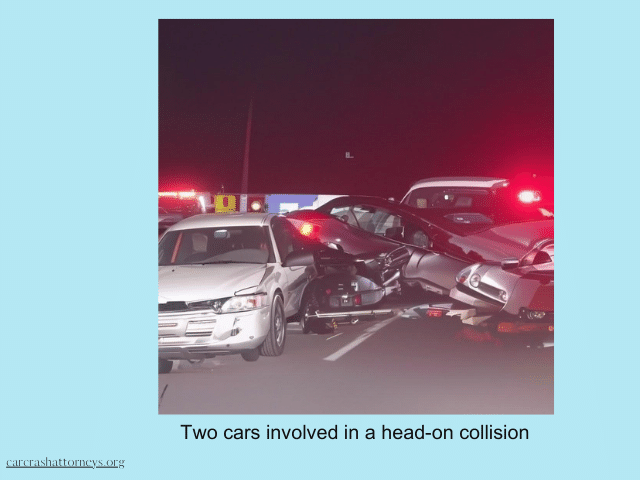
Head-on collisions happen when two vehicles traveling in opposite directions crash into each other, often with devastating consequences. These types of accidents are particularly dangerous due to the increased force of impact generated by the vehicles moving toward each other prior to the collision. In fact, when a head on collision occurs, the severity of the crash is often magnified. In 2020, head-on car crashes accounted for approximately 10% of fatal motor vehicle accidents, resulting in an estimated 3,631 fatalities.
Various factors can contribute to head-on collisions, including:
Driver error
Narrow lanes
Inadequate lighting
Absence of guardrails or traffic dividers
Excessive speed
Negligence
Driving under the influence
These are common causes of car accidents.
Bear in mind, the injuries resulting from a head on accident, such as a head-on collision, are usually catastrophic and may cause death.
Types of Head-On Collision
Head-on collisions can involve not only two vehicles traveling in opposite directions but also a vehicle impacting a stationary object, such as a tree, light pole, or cement barrier. In these cases, the same devastating forces are often at play, leading to severe injuries or death. On rural two-lane highways, illegally passing on a double yellow line is a frequent cause of head-on collisions.
Another type of head-on collision is the sideswipe accident, wherein two vehicles traveling in opposite directions make contact and cause scraping along the sides of each vehicle. Although sideswipe collisions are generally less severe than other head-on collisions, they can still result in property damage and potential injuries to vehicle occupants.
Factors Contributing to Head-On Crashes
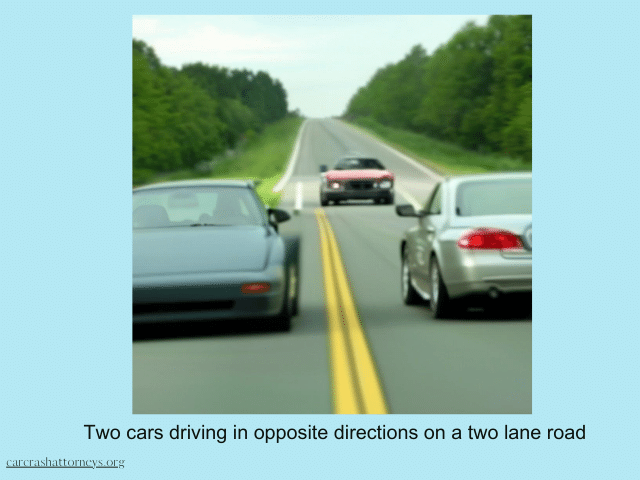
Inattentive driving is often the root cause of head-on collisions, with driver confusion, fatigued driving, and distracted or impaired driving posing significant risks. Environmental conditions such as visibility impairments caused by weather, road design, and inadequate lighting can also contribute to these accidents. In some cases, vehicle defects such as faulty brakes, steering, and tires can lead to head-on crashes.
Head-on collisions can be avoided if drivers:
Stay attentive to the roadway and oncoming traffic
Follow posted signs
Avoid veering into the opposing traffic lane
Refrain from moving in the wrong direction
By staying alert and practicing safe driving habits, drivers can significantly reduce their risk of being involved in a head-on crash.
Driving Conditions and Road Design
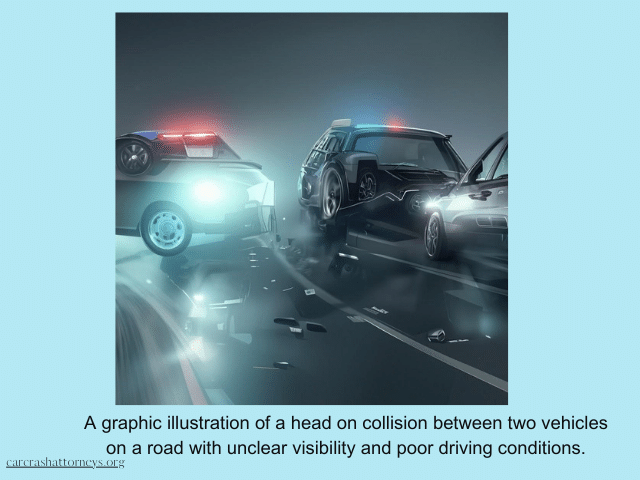
The role of driving conditions and road design in head-on collisions is significant. Some factors that can contribute to head-on crashes include:
Poor signage
Inadequate road maintenance
Confusion and misjudgment among drivers
Wrong turns or missed turns due to poor signage
These factors can increase the risk of head-on collisions and should be addressed to improve road safety.
In addition, certain driving behaviors can increase the likelihood of head-on collisions. These behaviors include:
Distracted driving
Driving under the influence of alcohol or drugs
Driving while fatigued
Passing improperly
Speeding
Driving too fast for existing conditions
Following the vehicle ahead too closely
Aggressive weaving through traffic
Shoulder driving
All of these factors can contribute to head-on crashes.
Determining Liability in a Head-On Collision
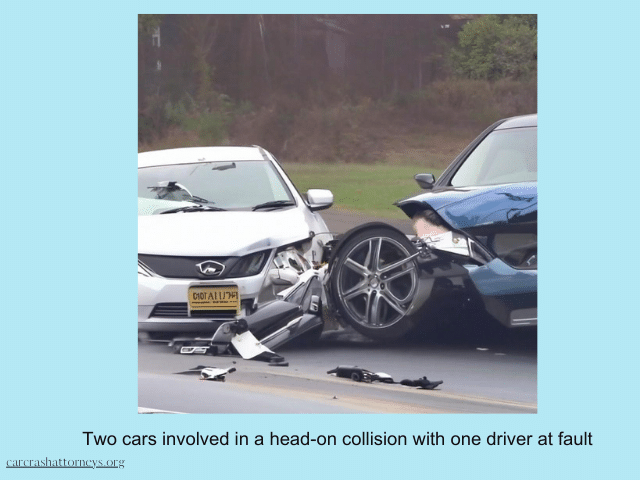
Determining who is legally liable for providing compensation to the affected parties hinges on establishing fault in a head-on collision. In most cases, the at fault driver is the one traveling the wrong way, deemed responsible for the head-on collision. However, a driver may not be held liable in cases of:
sudden medical emergency
tire blowout
steering defect
inadequate roadway maintenance
removal of a road sign.
Negligence, defined as a failure to exercise reasonable care to prevent causing injury to another, is typically a factor in head-on collisions. Reasonable care in a head-on collision entails:
remaining attentive to the roadway
adhering to posted signs
avoiding drifting into the opposing lane of traffic
abstaining from driving in the wrong direction
Physical evidence located at the scene, such as skid marks and debris, can be used to substantiate who was responsible for the head-on collision.
Comparative Fault vs. Contributory Negligence
When determining liability in head-on collision cases, two legal concepts come into play: comparative fault and contributory negligence. In comparative fault states, victims may still pursue a claim against the other at-fault motorist, even if they are found to be partly responsible. The amount of compensation awarded to the victim may be reduced if they are found to be partly at fault.
Contributory negligence states do not permit victims to pursue a claim if they are partially responsible. Therefore, if a motorist is found to be 1% accountable for causing a head-on collision, they are unable to obtain compensation from the individual who is 99% at fault.
As the laws specific to comparative fault and contributory negligence are state-dependent, consultation with a personal injury attorney to comprehend your rights and alternatives in a head-on collision case is advised.
Evidence Collection and Accident Reconstruction

In head-on collision cases, building a strong case for compensation and establishing fault heavily rely on evidence collection and accident reconstruction. Properly documenting the incident includes:
Taking photos of the front-end damage
Documenting the resting points of the vehicles
Noting the location of debris and skid marks
Gathering the names and contact information of any eyewitnesses
These steps can greatly strengthen your case.
Accident reconstruction experts can analyze the evidence and compare it to the respective drivers’ accounts, determining which driver was driving on the wrong side of the road, and the cause of the collision. The more evidence collected and the more accurate the accident reconstruction, the stronger your case will be when seeking compensation for injuries and damages sustained in a head-on collision.
Role of Personal Injury Attorneys
Personal injury attorneys play a vital role in the aftermath of a head-on collision. They can help:
Gather evidence
Determine fault
Ensure that you receive the full amount of compensation for any injuries and damages incurred
Facilitate the engagement of an accident reconstruction expert, further strengthening your case.
An experienced car accident attorney can also guide you through the legal process, providing support and advice at every step of the way. From filing a claim to negotiating with insurance companies and, if necessary, advocating for your rights in court, a personal injury attorney can be an invaluable resource in the pursuit of compensation following a head-on collision. In such cases, seeking assistance from car accident lawyers is crucial to ensure the best possible outcome.
Injuries and Damages in a Head-On Collision
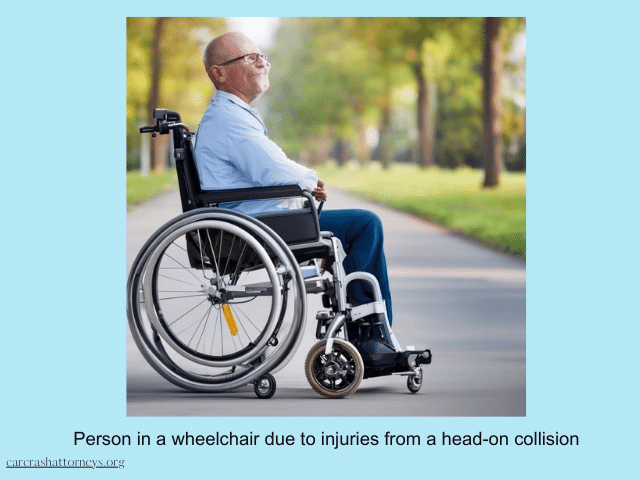
Head-on collisions can result in a wide range of injuries and damages, including:
Traumatic brain injuries (TBI)
Spinal cord injuries
Neck injuries
Soft tissue damage
In some cases, head-on collisions can even result in wrongful death.
In a head-on collision case, one might seek compensation for:
Medical costs
Medication
Lost wages
Pain and suffering
Reduced earning potential
Other financial losses
Obtaining the appropriate compensation can be crucial for victims and their families, as it can help alleviate the financial burden of medical bills, rehabilitation costs, and lost income due to the accident.
Long-Term Consequences and Rehabilitation
The long-term consequences of head-on collision injuries can be significant and far-reaching. Some of these consequences include:
Traumatic brain injuries
Spinal cord injuries
Neck injuries
Decreased cognitive capacity
Long-term physical and cognitive impairments
Persistent pain
Difficulty with everyday activities
Furthermore, head-on collisions can lead to post-concussion syndrome, which can bring about symptoms such as dizziness and headaches that can persist for months.
Receiving medical attention and rehabilitation after a head-on collision is essential to mitigate the long-term effects of the accident and assist the victim in resuming their everyday activities. Rehabilitation can aid in reducing the intensity of these long-term outcomes, helping the victim regain their independence and improve their overall quality of life.
Legal Process and Compensation for Head-On Collision Victims
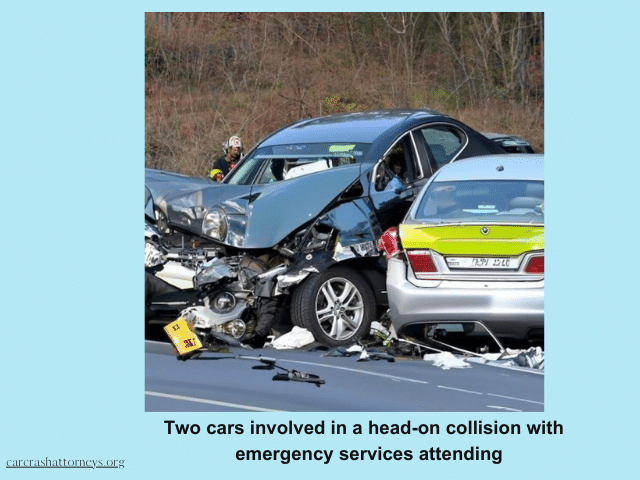
Navigating the legal process following a head-on collision can be complex and overwhelming, especially for victims and their families who are already dealing with the physical and emotional consequences of the accident. In addition to establishing fault and liability, victims must also consider the potential compensation they may be entitled to, including medical expenses, lost wages, and pain and suffering.
In this process, a seasoned personal injury attorney can offer invaluable assistance in evidence gathering, fault determination, and negotiation with insurance companies to ensure victims get the compensation they deserve. By advocating for their clients’ rights and providing support throughout the legal process, personal injury attorneys can help ensure that head-on collision victims receive the compensation they need to move forward with their lives.
Settlements vs. Court Trials For Head-On Collisions
When pursuing compensation for a head-on collision, victims have two primary options: settling the case out of court or going to trial. Settling out of court can have several advantages, including avoiding the time and expense associated with a trial, as well as the uncertainty of a jury verdict. However, settling out of court may also mean not receiving the full amount of compensation that may be available through a trial.
Personal injury attorneys play a crucial role in helping victims weigh the pros and cons of settling versus going to trial and can negotiate on their behalf to secure fair compensation. Ultimately, the decision to settle or go to trial will depend on the specific circumstances of each case, and an experienced attorney can help guide you in making the best choice for your situation.
Preventative Measures and Safe Driving Practices
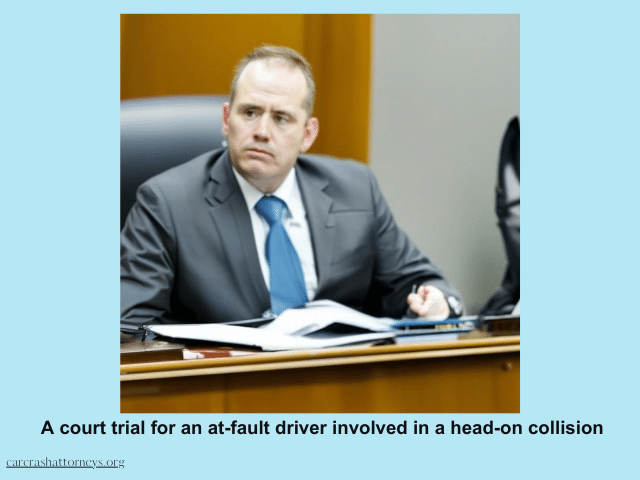
The prevention of head-on collisions is paramount, given that they often lead to severe injuries or loss of life. By practicing safe driving habits and adhering to traffic regulations, drivers can significantly reduce their risk of being involved in a head-on collision. Defensive driving techniques such as maintaining a safe following distance, avoiding tailgating, and being aware of blind spots can also help reduce the risk of head-on collisions.
Staying alert and avoiding distractions while driving is crucial for preventing head-on crashes. This includes avoiding cell phone use, eating, or talking to passengers while driving, taking regular breaks, and avoiding driving when fatigued. By remaining attentive and focused on the road, drivers can minimize their risk of head-on collisions and help ensure the safety of themselves and others on the road.
Vehicle Safety Features
Modern vehicles are equipped with a variety of safety features designed to help prevent head-on collisions and protect occupants in the event of a crash. These features include:
Airbags
Seatbelts
Crumple zones
Anti-lock brakes
Airbags provide cushioning and defense for the head and chest in the event of an accident, while seatbelts restrain occupants and reduce the potential for harm. Crumple zones absorb the impact of a crash, reducing the force of the impact on vehicle occupants, and anti-lock brakes help maintain control in the event of a crash, reducing skidding and the risk of head-on collisions.
Drivers can markedly lessen their risk of involvement in a head-on collision with the other driver and minimize injury potential through the utilization of these safety features.
Summary
In conclusion, head-on collisions are among the most devastating types of car accidents, often resulting in severe injuries and fatalities. Understanding the causes, consequences, and legal ramifications of these accidents is crucial for anyone who spends time on the road. By practicing safe driving habits, employing defensive driving techniques, and utilizing modern vehicle safety features, drivers can significantly reduce their risk of being involved in a head-on collision.
As we have seen, navigating the complex legal landscape following a head-on collision can be challenging, but with the help of an experienced personal injury attorney, victims can secure the compensation they need to move forward with their lives. By staying informed and aware of the risks and potential consequences of head-on collisions, we can all contribute to making our roads safer for everyone.
Frequently Asked Questions
What happens head-on collision?
In a head-on collision, the head and neck of the victim will jerk forward due to the sudden motion of whiplash, which causes the ligaments and muscles in the neck and back to stretch. This can be avoided if the victim is wearing a seatbelt.
What is the survival rate for a head-on collision?
The odds of surviving a head-on collision are slim, with statistics showing that vehicle occupants face a 58% fatality rate and the chances dropping to 25% when travelling at 70 mph. Such collisions are the second most deadly type of accident, behind only rollover accidents.
Is a head-on collision the worst possible crash?
A head-on collision is by far the deadliest accident type, making it the worst possible crash. Even a collision at lower speeds can be catastrophic due to both vehicles’ speed at the time of impact.
What is a head-on collision called?
Head-on collisions, also known as front-impact accidents or frontal crashes, occur when two vehicles traveling in opposite directions collide from front end to front end and can cause serious injuries and damage. These types of accidents can be particularly dangerous due to the high speed of the vehicles and the lack of time for drivers to react. The impact of the collision can cause severe damage to both vehicles, as well as serious injuries to the occupants. In some cases, head-on collisions can
What is considered a head-on collision?
A head-on collision (also known as a frontal collision) occurs when two vehicles travelling in opposite directions collide into each other, or when one vehicle drives straight into a stationary object. They can happen with cars, trucks, or motorcycles and can result in serious damage to both vehicles.
Further Reading: Frontal Collisions
Legal Disclaimer: The content provided on carcrashattorneys.org is for general informational purposes only. It is not intended as legal advice, nor does it constitute an attorney-client relationship. The information may not be accurate, complete, or updated when viewing. Carcrashattorneys.org and its authors disclaim all liability for any actions taken or not taken based on the content of this site. Always consult with a licensed attorney in your jurisdiction before making any legal decisions. This website may contain links to other websites. We are not responsible for the content, accuracy, or opinions expressed in such websites, and such websites are not investigated, monitored, or checked for accuracy or completeness by us.
